Email marketing is still one of the most powerful tools you can use as part of your wider marketing strategy. But is it worth the price tag, especially when other channels like SMS are so effective?
There are countless platforms and additional features available, so costs can vary quite widely. This leaves people wondering what kind of return they can realistically expect to get.
So our team has broken down what email marketing costs in 2025, from budget-friendly options to premium setups. We’ll also put those numbers in context by looking at how email ROI compares to other marketing channels.
What Does Email Marketing Cost in 2025?
It depends on the scale of your business and how you execute your campaigns:
Cost Breakdown by Business Size
The prices change based on how big your business is:
Freelancers & Solopreneurs
Email marketing can be incredibly cheap to start if you’re a one-person show or running a side hustle. Most email platforms have free plans for small lists (often up to 500 contacts), and entry-level paid plans might run under $10-20 a month.
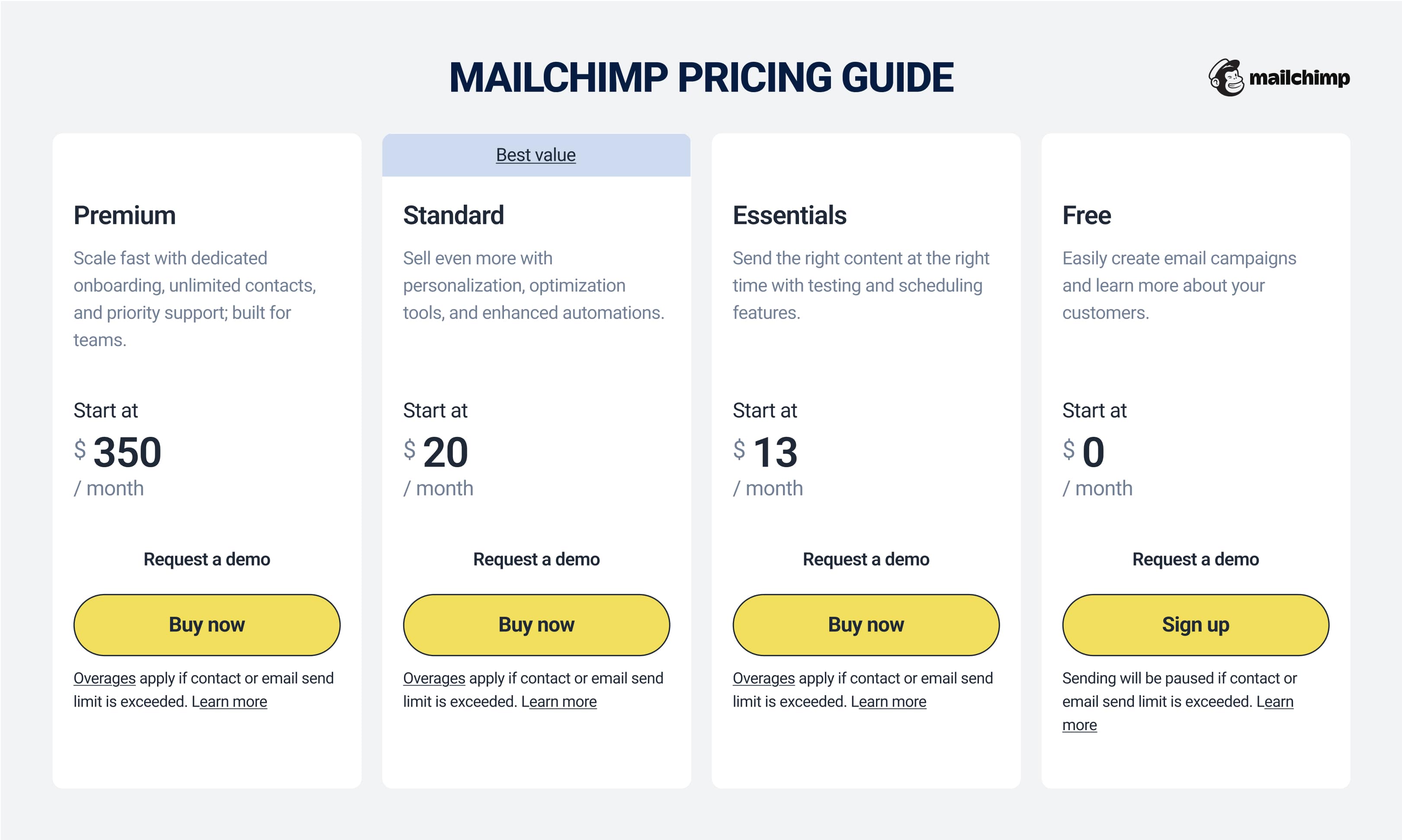
Smaller businesses usually spend no more than $15-$40 monthly on basic email marketing. At this level, you’re likely doing everything yourself:
- Using built-in templates
- Writing your own copy
- Focusing on plain but effective emails
Your main costs are the software (which might even be free) and your time.
Small-to-Mid-Sized Businesses (SMBs)
The costs increase as your business and subscriber list grow. For example, sending to around 10,000 subscribers could cost in the range of $70-$140 per month just for the platform.
On top of that, you might hire a freelance designer or copywriter for certain campaigns, or pay for additional tools (like advanced automation or analytics). That said, the costs are still manageable relative to many other marketing channels.
Enterprise-level Operations
Big companies with massive email lists often have the budget to match. They might use enterprise-grade email marketing software or marketing automation platforms that charge premium prices, sometimes $1,000 to $5,000+ per month just for the software license.
So an enterprise could easily spend $5,000 or more monthly on email marketing for a fully managed, high-volume program.
But that figure usually includes:
- Advanced ESP (Email Service Provider) costs
- Additional tools for deliverability and segmentation
- The manpower to run it all
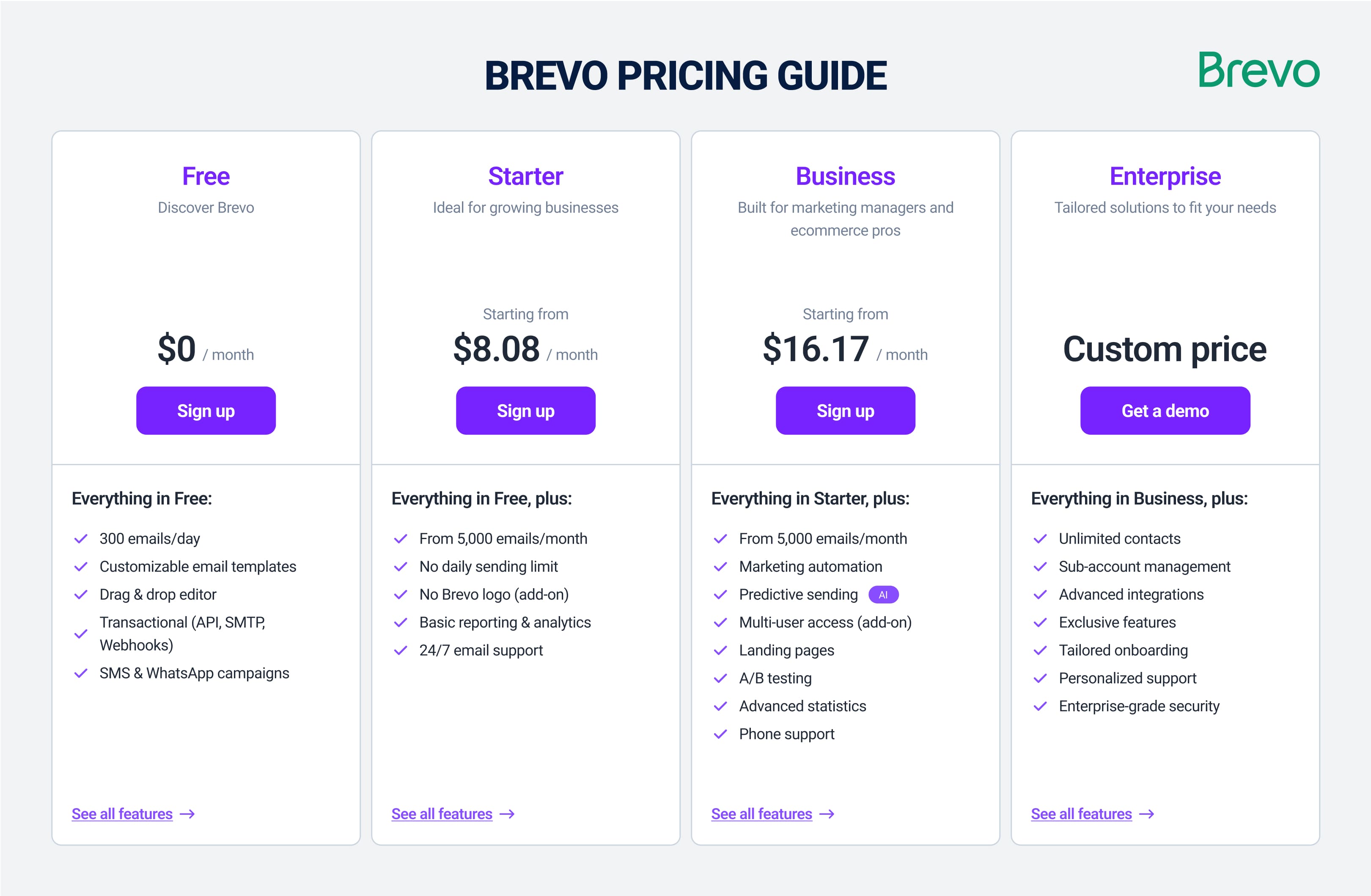
Types of Costs You’ll Encounter
These are the main types of costs involved in running email campaigns:
Email Platform/Software Fees
This is what you pay your Email Service Provider (ESP) to send emails, which is usually based on your subscriber count or email volume.
For instance, MailChimp’s Premium tier (with all the best add-ons) starts at $350 per month. You would choose this one if you had a huge subscriber list. Whereas Brevo’s $9 Starter tier is better suited to low subscriber lists from new companies.
Content Creation (Copywriting & Design)
You need writers or designers to make compelling email copy. If you outsource email copywriting, it can range from roughly $50 to $2000 per email depending on the writer’s experience and the email’s complexity.
Using your in-house team or free templates can save money here, but it’s not uncommon for businesses to invest heavily in making good copy based on the potential ROI.
List Management & Data Hygiene
You’ll want to use tools to remove inactive subscribers or bad addresses periodically. These services often charge per contact (e.g. around $5-$15 per 1,000 emails to scrub out bounces and spam traps).
This is what you might consider a “hidden” cost, but it’s worth it because a clean list improves deliverability (and thus ROI). And storing a huge list on your platform costs more, so trimming the dead weight saves budget.
Automation and Tech Integration
Most platforms usually include basic automation (like a simple welcome sequence), but advanced workflows or integration with other systems are extra.
You might need to upgrade to a higher-tier plan or pay for add-ons to get features like:
- CRM integration
- Advanced segmentation
- Event-triggered emails
These costs can even include investing in a developer’s time to connect your ecommerce site or CRM with your email platform.
There are also infrastructure costs if you go big. For example, a dedicated sending IP address for better deliverability might cost ~$50/month.
Inbox placement monitoring tools can cost $50-$500/month for high-volume senders. These tools ensure that emails land in inboxes and not spam folders.
Compliance & Legal (GDPR, CAN-SPAM, etc.)
Some email services only include GDPR compliance tools (like consent tracking and data management) in higher-tier plans.
If you handle a lot of personal data (think of things like cookie consent or subscription management portals), you might also want to invest in legal counsel or specialized software.
Hidden Costs Nobody Talks About
Even with all the obvious line items covered, there are some sneaky costs in email marketing that don’t always show up on an invoice but can impact your bottom line:
Subscriber Acquisition
To actually build your list you need to run ads and create lead magnets (like free ebooks or discounts). Those costs may not be labeled “email marketing” but they are essential to grow your list.
Time & Labor (Opportunity Cost)
Email marketing it requires human effort to:
- Strategize
- Write content
- Design templates
- Segment lists
- Analyze performance
If you or your team are spending 5-10 hours a week on emails, that’s time not spent on other tasks. There’s a real opportunity cost to that labor. Many small businesses start doing email in-house thinking it’s free, only to realize it eats up a significant chunk of someone’s time (or requires hiring an extra hand).
Deliverability Issues
You might be paying for an email blast that no one actually sees if your emails land in spam or promotions folders instead of the inbox.
But fixing deliverability also costs money (you might purchase tools or consulting to improve inbox placement). This is why we harp on list hygiene and quality content because they protect your sender reputation.
Email Marketing Service Costs
| Service Component | Typical Cost Range (2025) | Notes & Real-Life Context |
|---|---|---|
| Time Investment & Strategy Setup | 10-30 hours upfront (your time or paid expert) | Crafting your strategy and defining audience segments. Can take 1-2 weeks if DIY. |
| Cold List Cleanup & Subscription | $0.005-$0.02 per email address | Using tools to verify emails and remove bad addresses to improve inbox placement. |
| Team Training or Outsourcing Fees | $50-$150/hour (consultants) or $500-$3,000/month (agency) | Training your team to handle email in-house, or outsourcing to a specialist or agency. |
| Opportunity Cost of Poor Segmentation | Hard to quantify. Can cost thousands in lost sales | Sending irrelevant messages can tank engagement and churn subscribers. |
| Platform Onboarding & Setup | Often free (self-setup) or $200-$1,000 (for help) | Some providers offer free onboarding; agencies may charge for initial configuration. |
How Does Email Marketing ROI Compare to Its Cost?
So, how much money can email marketing make in return?
Average ROI Benchmarks in 2025
Email marketing has a reputation for stellar ROI, and the data backs it up. On average, 35% of businesses see roughly $36-$42 in revenue for every $1 spent on email marketing.
To put it in perspective, social media marketing returns around $2.80 per $1 spent in comparison.
Of course, ROI can differ by industry and approach. Here are some examples of average ROI by sector (the following figures are from Litmus):
- Retail & Ecommerce: ~45:1 ROI (e.g., retail brands often get around $45 back per $1 spent on email).
- Marketing/Advertising agencies: ~42:1 ROI.
- Software & Technology companies: ~36:1 ROI.
- Media, Publishing & Events: ~32:1 ROI.
So consumer-facing industries like retail tend to squeeze the most value out of email, often because of frequent promotional emails and large sale events. Even the “lower” end of the spectrum (around 30:1) is extremely high compared to other marketing tactics.
Remember that he often-quoted figures in the 30:1 or 40:1 range assume a mature program.
That said, there are still real-life cases of ridiculously high ROI from email. For instance, one Chicago hotel ran email campaigns that achieved over 215:1 ROI at their peak after a major re-opening. That translated into tens of thousands in revenue.
Key Factors That Influence ROI
If your email ROI isn’t hitting those benchmarks it’s the result of several key factors that you can optimize:
List Quality and Segmentation
You’ll get better results if you’re sending relevant content to people who want it because you’ve filtered out uninterested people (so you’re not wasting sends) and you’re grouping subscribers by interest or behavior.
And segmentation means your emails resonate. For example, sending different content to customers vs. prospects or high-spenders vs. occasional buyers. This directly boosts ROI because every email is more likely to drive action.
Frequency and Content Quality
How often you email and what you say has a huge impact on ROI. Too many emails annoy people (leading to unsubscribes or diminishing returns). Too few leaves money on the table by not staying in touch.
More important than an exact number is consistency and value. Every email should provide something useful, from promotions to useful info or entertainment. If your content is spammy or bland, even a big list won’t save your ROI.
Funnel Integration and Lifecycle Emails
Email works best when it’s part of a bigger customer journey, so think how your emails nurture leads and support sales at each stage. For instance, offering a compelling lead magnet (like a free guide or discount) gets people onto your list; then a welcome series warms them up.
If you’re in ecommerce, abandoned cart emails can recover otherwise lost sales (these automated reminders often convert a percentage of those would-be drop-offs). For B2B, drip campaigns can educate prospects over weeks until they’re sales-ready.
The idea is that each email sequence moves the subscriber closer to a purchase or retention. Then your ROI shoots up because every message has a purpose and a targeted audience.
GROW YOUR INSTAGRAM FOLLOWING VIA OUR CELEBRITY CAMPAIGNS
Leverage the power of the worlds A-list celebrities to grow your Instagram every month
VIEW CAMPAIGNSTiming, Automation, User Intent
A well-timed email on a user’s birthday, or right after they checked out a product on your site, can feel personal and increase the likelihood of conversion. If someone just showed intent (say, by downloading a trial or viewing a pricing page), an automated follow-up email can capitalize on that interest.
Timing also means paying attention to things like time of day or day of week (though that tends to have minor effects compared to content relevance). Automation makes it all scalable by doing it hands-off once you set it up.
ROI Calculation: Simple Formula with Real Example
Calculating email marketing ROI is just: ROI = (Revenue from email - Cost of email) / Cost of email. Then you can multiply by 100 to express it as a percentage. You can also express ROI as a ratio (like 5:1 or 10:1) by dividing revenue by cost.
As an example:
One month you spend $500 on email marketing (this includes your platform fees, maybe a bit in paid content creation, etc.) and the campaigns you send generate $5,000 in direct sales that month.
- Your net revenue (revenue minus cost) is $5,000 - $500 = $4,500 net gain.
- Divide that net gain by the cost ($4,500 / $500) = 9.
- In percentage terms, that’s 900% ROI. In ratio terms, it’s 10:1 ROI (because you earned 10 times what you spent).
One thing to keep in mind when calculating ROI: you want to attribute the revenue accurately. That means you should be able to track which sales or leads came from your email campaigns (via tracking links or unique coupon codes, for example).
Email often assists other channels too (like driving a customer back to your site where they might purchase via a different channel), but the simplest ROI calc looks at direct attributable revenue.
Comparing Email Marketing Cost vs. Other Channels
How does email weigh up against other marketing channels?
Email vs. Social Media Marketing
With email, you own your list of subscribers. Your emails reach everyone on your list (barring those who ignore or land in spam).
With social media marketing on platforms like Facebook or Instagram, you’re at the mercy of algorithms and paid promotion to reach your audience.
From a cost perspective, posting organically on social media is “free” in terms of platform use, but reaching your audience often requires significant content creation effort and/or ad spend. If you want to guarantee visibility on social media, you usually have to pay, either by running ads or sponsoring posts.
Those costs can add up (social ad CPCs and CPMs vary, but you might pay anywhere from a few cents to several dollars per click, depending on the platform and targeting).
By contrast, sending an email to 1,000 subscribers or 100,000 subscribers might cost the same flat software fee or just a bit more - there’s no per-click charge on each email open.
Email’s average ROI is around 36:1, while social media’s average ROI is closer to 2.8:1. In fact, email is nearly 40 times more effective at acquiring customers than Facebook and Twitter combined.
It doesn’t mean social media isn’t valuable; it’s still great for brand awareness and engagement. But when it comes to driving direct conversions per dollar, email usually wins.
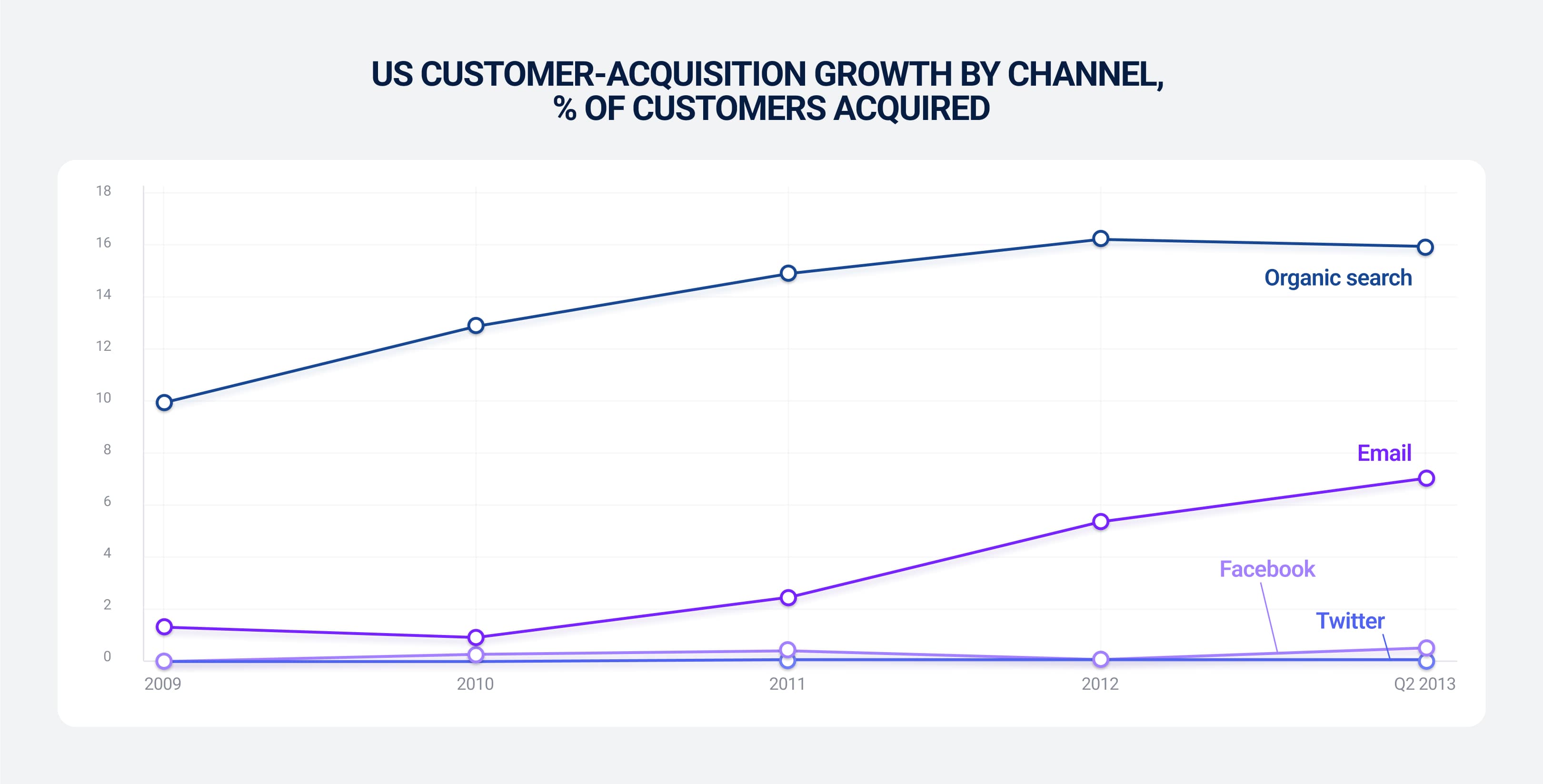
Time-to-ROI is also a factor. If you send a promotional email, you might see sales roll in that very day from that email.
With social media, you often have to nurture an audience with regular content and immediate sales from an organic post are less guaranteed (unless you’re running a specific ad campaign).
Social content also tends to have a short lifespan. A tweet or Facebook post gets most of its engagement in the first few hours, then fades away. An email in someone’s inbox might sit unread, but there’s a chance they’ll see it later when checking email.
Email vs. Paid Ads (PPC, Meta, Google Ads)
With paid ads, you’re paying every time someone sees or clicks your marketing content. With email, you pay a fixed cost to send, no matter how many people open or click.
A big advantage of email is the predictability of cost. If you have a list of 50,000 subscribers, you generally know “I’m paying $X per month for my email tool, and I can email them as much as I need.”
With PPC, cost can be volatile because bid prices can spike if competitors target the same keywords or audience. One month you might get clicks for $1 each, the next month it’s $2 each due to competition or seasonality. Email is a lot more stable cost-wise.
ROI-wise, we’ve already seen email wins. Typical returns for paid ads are much lower than email. For example, Google Ads (search PPC) often returns about $8 in revenue for every $1 spent on average.
Facebook and Instagram ads might be in the $2-$4 revenue per $1 range for many businesses. Those can still be profitable, but they don’t touch email’s ~$36 per $1 benchmark.
Part of the reason is that with ads, you’re often paying to reach cold audiences, while with email you’re reaching warm contacts who already know you.
Scalability and Cost Volatility
Scalability is another consideration. If you want to reach more people with ads, you generally pay more linearly; double the budget roughly doubles the clicks (until you saturate your audience).
With email, once you’ve built a large list, sending an extra campaign or adding another drip sequence doesn’t typically increase cost significantly. This means email can scale
communication at a low marginal cost. Ads, on the other hand, have a directly proportional cost to scale and sometimes diminishing returns as you try to expand to broader audiences.
There’s also asset vs. expense at play. An email list is an owned asset - you can tap into it over and over. Paid ad campaigns are a pure expense - you pay, you get some results, but once you stop paying, the traffic stops.
You might pay to acquire an email subscriber via paid search or social ads, but once they’re on your list, you can remarket to them via email essentially for free (or for very little).
That said, paid ads can generate immediate visibility and reach audiences that email can’t (for example, new prospects who haven’t heard of you yet). They’re highly controllable and can be scaled up quickly when you need a burst of leads or sales. But in a pure cost vs. ROI shootout, email usually has the upper hand for sustaining customer relationships and repeat sales.
Email vs. SEO & Content Marketing
SEO and content marketing involve creating blog posts, infographics, etc., to attract people via Google and other platforms. The costs here are primarily in content creation and optimization (paying writers or your own time).
The results also take time as it could be months after you publish an article before it ranks and brings in steady traffic. But once it does rank, that traffic is essentially free (no ongoing ad spend) aside from maintaining or updating the content.
Email, by contrast, reaches people who have already interacted with your brand (e.g. they signed up or bought something). SEO/content is great for acquisition, but email is better at retention and conversion of those people.
So a lot of companies put effort into SEO and content marketing to build an audience, then use email to keep engaging that audience. They work hand-in-hand.
In terms of pure cost vs ROI, both email and SEO are often cited as the highest ROI channels. Neither charges you per user engagement beyond your investment in creating the content or managing the list.
If you do SEO right, one high-quality piece of content could generate thousands of visits and leads over its lifetime. But it’s hit or miss because not every article will be a winner, and there’s a lot of competition out there. Email’s advantage is that once someone’s on your list, you have a direct line to them without needing Google’s blessing.
When Email Marketing Is Not Worth the Cost
Given email’s high ROI, is there ever a time when it isn’t worth it?
No Audience or List to Speak of
Your initial marketing dollars might be better spent generating awareness or acquiring those first users (through channels like PR or ads) before you worry about email.
Email isn’t worth much if you have no one to send to; it’s usually something you come onto after you have at least some customer base or subscriber list.
Audience Not Using Email
Almost everyone has email, but if your target demographic just doesn’t respond to emails or doesn’t check their inbox (say you’re targeting a teen audience that practically lives on TikTok/Instagram and ignores email), you might get better ROI focusing on platforms they do use.
SMS marketing or in-app notifications can be more effective than email due to the nature of their audience or product.
Lack of Content or Bandwidth
If you don’t have the resources to create valuable content or offers, you could end up spending on an email platform and sending dull, infrequent emails that generate little return.
If you know you can’t commit to doing it well (or hiring someone who can), those resources might be better used elsewhere until you’re ready.
Other Channels Have Higher Immediate Payoff
Depending on your industry, you might have a marketing channel that outperforms email. For example, some companies get most of their sales through a strong affiliate marketing network or through heavy outdoor advertising campaigns that directly drive foot traffic.
One-and-Done or Very Infrequent Transactions
If your customers buy once and never again (or only after a very long time), like life insurance, for example, the ROI of maintaining a lengthy email conversation with them may be low.
In contrast, a retail brand with new products each season thrives with email. You’ll quickly realize that the lifetime value from emails is limited if you don’t have repeat value.
If It’s Done Wrong (Spammy Tactics)
Email marketing is not worth the cost if you’re just buying lists of random emails and sending unsolicited blasts without personalizing them. Those tactics usually lead to low engagement and can hurt your sender reputation. You’ll be paying for an email service and getting nothing in return.
How to Maximize ROI on Any Email Budget
Here’s how to maximise your return on any email spend:
Prioritize These High-Impact Areas
Focus on the most profitable movies:
Build a Quality List (Not Just a Big One)
It’s better to have 1,000 engaged subscribers than 10,000 who don’t care. Use:
- Double opt-ins
- Clear signup forms
- Incentives that attract genuinely interested people
Nail the Welcome & Onboarding Emails
Set up an automated welcome series for new subscribers or customers:
- Introduce your brand
- Provide value
- Maybe offer a first-purchase discount
Welcome emails often have some of the highest open rates (since people are most interested at the start).
Recover Lost Opportunities (Abandoned Carts & Re-engagement)
Abandoned cart emails are usually one of the highest-ROI emails because it targets people who almost bought. A simple reminder or extra incentive can win back a sale with minimal effort.
And have a strategy for re-engaging lapsed customers or subscribers. Something like “We miss you, here’s 20% off” to someone who hasn’t purchased in 6 months can be effective.
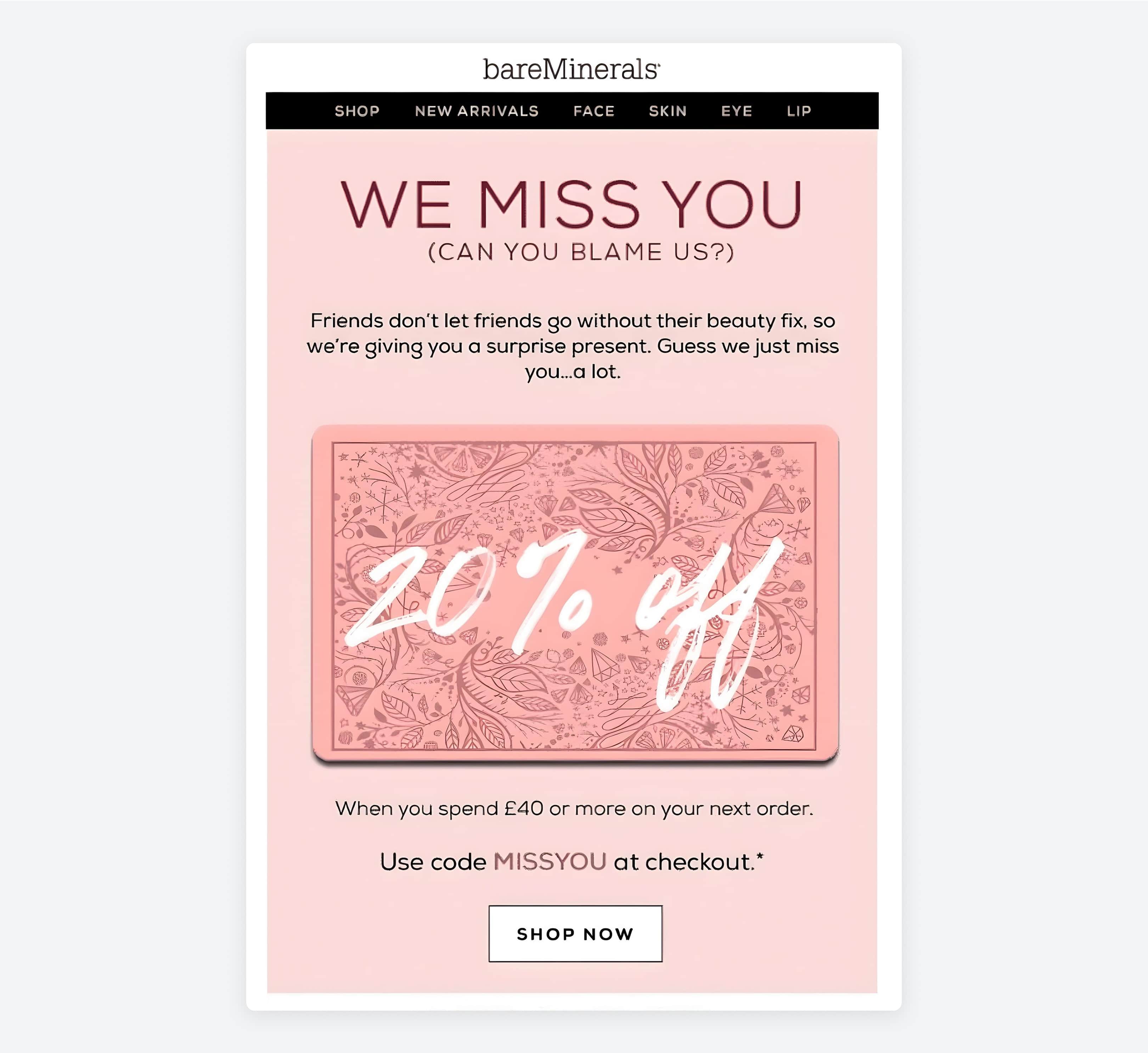
Test and Optimize Continuously
Little tweaks can mean a lot when multiplied over thousands of emails. A/B test your subject lines to improve open rates; it’s a quick experiment that can lead to significantly more eyes on your message.
Also pay attention to your analytics: if certain content gets more clicks, do more of that. If some emails get barely any opens, figure out why.
Maintain Deliverability and Compliance
ROI counts for nothing if your emails don’t reach people. So keep your sender reputation healthy. That means:
- Regularly cleaning out unengaged addresses (don’t keep spamming people who never open because it hurts deliverability)
- Honoring unsubscribes promptly
- Following compliance laws
- Using double opt-in (or at least make sure you’re sending to people who gave permission)
Automations That Save Time and Drive Revenue
You can set up automated flows that work for you 24/7:
Welcome or Onboarding Series
Do an automated sequence that triggers when someone joins your list or becomes a customer. You can drip out a few emails over the first week or two. For example:
- Day 1: Welcome/Thanks + maybe a special offer
- Day 3: Story about your brand or product usage tips
- Day 7: Testimonials or social proof to build trust, etc
Cart Abandonment Emails
If someone adds to cart but doesn’t check out (and you have their email), an automatic email reminder after a few hours can recapture the sale.
You might send one email saying “Oops, did something go wrong? Here’s your cart, complete your purchase.” and perhaps a second email a day or two later, maybe with a small discount as an incentive. These emails are known revenue-drivers for retail/ecommerce because they target high-intent people. And once you set it up, it just runs continuously whenever someone abandons a cart.
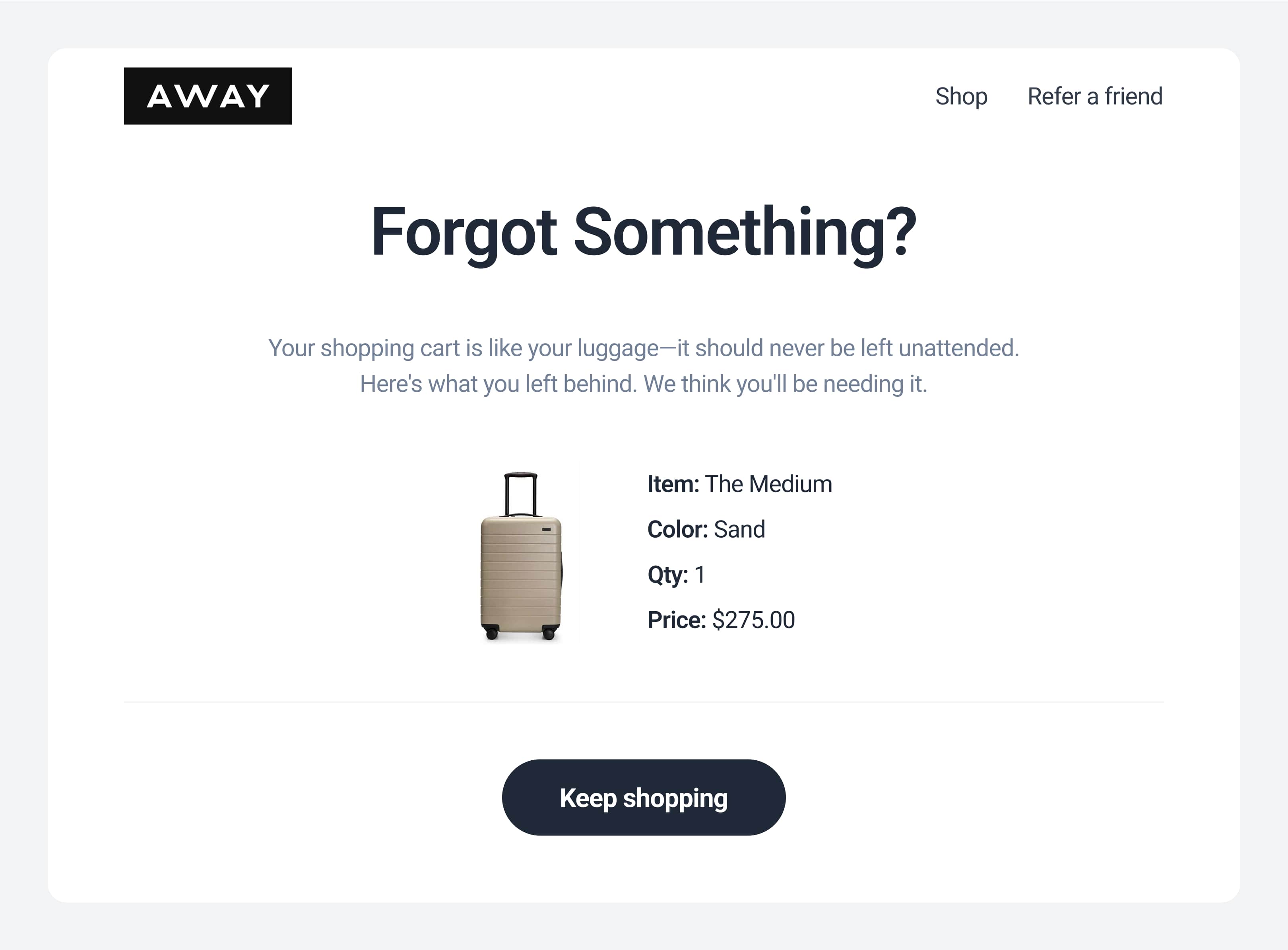
Post-Purchase Follow-Ups
After someone buys, don’t let the relationship drop off. Automate a thank-you email and perhaps a follow-up asking for a review or offering related products.
For example, three weeks after a purchase, you could send “How are you liking Product X? Here are some tips to get the most out of it.”
This not only can lead to repeat sales or upsells (by recommending complementary items) but also increases customer satisfaction. It’s way easier to sell to an existing customer again, and these automations help do that nurturing work for you.
Lifecycle and Trigger-Based Emails
Think about key moments in your customer’s journey and automate around them:
- Birthday or anniversary emails (e.g., “Happy 1 year with our service, here’s something special!”)
- Renewal reminders for subscription services (“Your annual plan expires next month - here’s why you should renew…”)
- Trigger emails based on behavior (like if a user of your app hasn’t logged in for 30 days, trigger a “anything we can help with?” email).
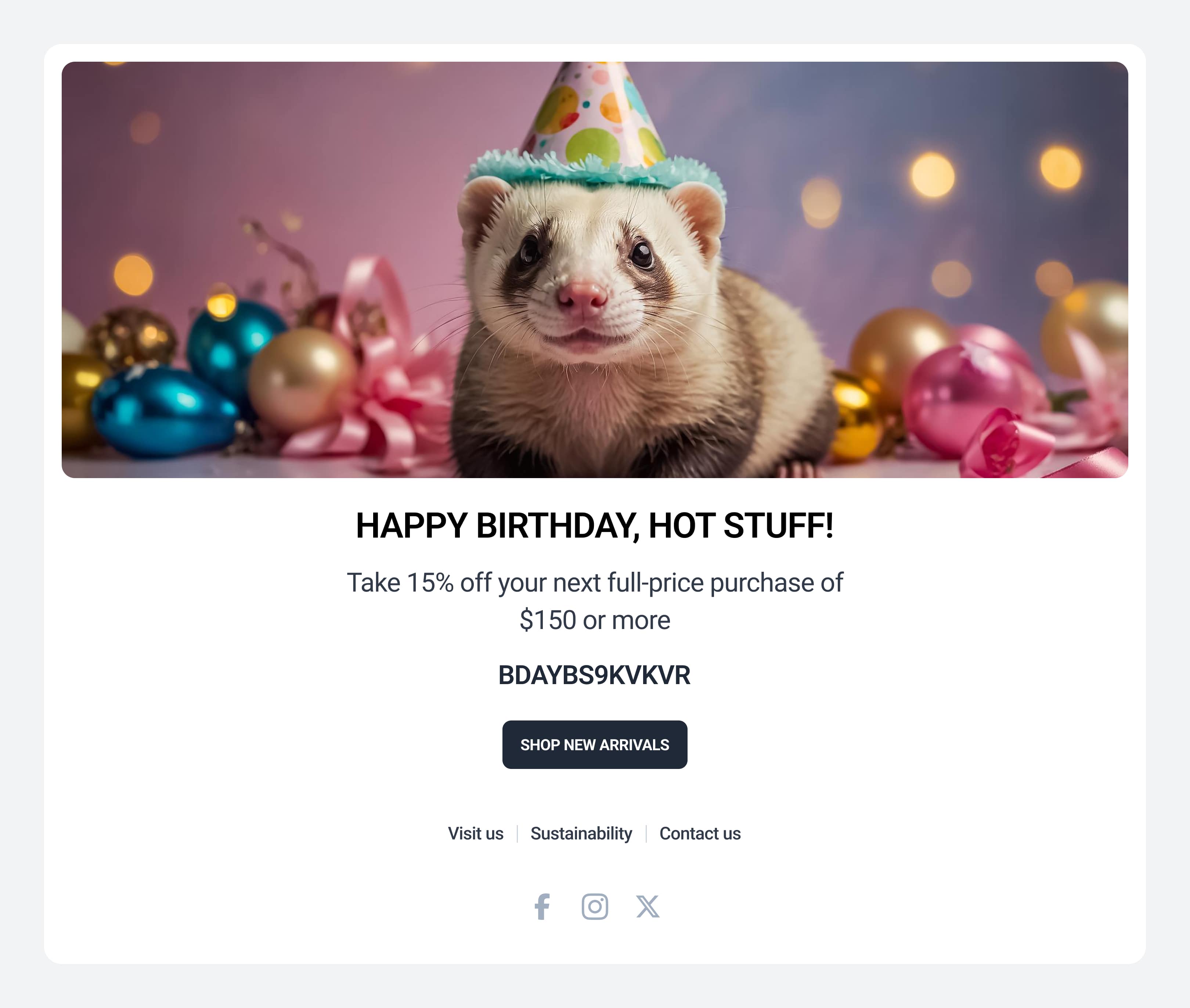
Best Tools That Deliver Value at Any Price Point
Choosing the right email marketing platform can make a difference in cost-effectiveness. So if you’re just starting or have a small list, look at tools like Brevo or the free tier of Mailchimp.
These often let you send to a few hundred or thousand subscribers for little to no cost. For instance, Brevo’s free plan allows up to 9,000 emails per month.
The functionality is a bit more limited, but the ROI is huge when you’re hardly paying anything.
And regardless of the platform, sometimes investing in a couple of extras can improve your ROI. For instance, using an email verification service (to periodically scrub bad emails) can save you money by keeping your list clean.
Or using advanced analytics (some services or third-party tools) can help identify which campaigns drive the most sales, so you can optimize. Many mid-tier and up platforms have these built-in, but if not, consider allocating a bit of budget to them.
Frequently Asked Questions
How Much Should Small Businesses Invest?
A small business can start email marketing with as little as $10-$50 per month on a basic plan. Focus your budget on a reliable ESP and then grow your engagement. After that, reinvest revenue back into email as your list and results expand.
What Tools Are Best for High ROI With Low Cost?
MailerLite and Mailchimp’s free tiers offer some solid features. This includes everything from templates and basic automation to analytics at minimal to no cost. They scale up affordably as your list grows, which means strong ROI without breaking the bank.
Can I Do Email Marketing Without a Paid Tool?
Yes. Many ESPs offer free plans that let you send to limited lists with add-ons like unsubscribe handling and templates. Using a proper free-tier service gets rid of deliverability issues and manual headaches of BCC campaigns in standard email clients.
How Long Does It Take to See ROI From Email Campaigns?
With an existing list, you can see sales from a well-crafted email within hours or days. If you’re building your list, expect positive ROI in a few months of consistent campaigns. It’s still much faster than channels like SEO or content marketing.
What’s the Cheapest Way to Grow an Email List?
Use lead magnets (like a free guide) and promotions at checkout or on social media. And encourage newsletter sign‑ups at every customer touchpoint. These organic tactics cost little to nothing and attract subscribers who truly want your content.
Is Hiring an Email Marketing Agency Worth It?
Hiring an email marketing agency can save you time and boost expertise if you lack in‑house resources. Agencies often achieve higher open and conversion rates through proven strategies. They’re definitely more expensive, but just compare their monthly fees to the incremental revenue they generate to see if it’s worth the investment.

